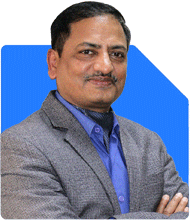Ramalingam Kalirajan |10219 Answers |Ask -Follow
Mutual Funds, Financial Planning Expert - Answered on Jun 05, 2024
He has an MBA in finance from the University of Madras and is a certified financial planner.
He is the director and chief financial planner at Holistic Investment, a Chennai-based firm that offers financial planning and wealth management advice.... more

If I have 70 lakh and I want to leave job of 60k per month due to some circumstances. What should I do to get atleast 30-35 k per month and grow money also.
Current Financial Situation
You have Rs 70 lakh in hand, which is a substantial amount. You are currently earning Rs 60,000 per month from your job. Your goal is to replace half of that income (Rs 30,000-35,000 per month) through investments.
Investment Goals
Regular Income
The primary goal is to generate a regular monthly income of Rs 30,000-35,000.
Wealth Growth
Additionally, you want your Rs 70 lakh to grow over time to ensure financial stability.
Investment Strategy
To achieve these goals, a diversified investment strategy is essential. This strategy will involve a mix of investments that provide regular income and those that offer growth potential.
Creating a Monthly Income Stream
Fixed Deposits and Debt Funds
Fixed deposits and debt funds are relatively low-risk investment options that provide regular interest income.
Fixed Deposits (FDs): These offer a fixed rate of return over a specified period. They are safe but provide lower returns compared to other investments.
Debt Funds: These invest in fixed-income securities like government and corporate bonds. They offer better liquidity and potentially higher returns than FDs.
Systematic Withdrawal Plan (SWP)
A Systematic Withdrawal Plan (SWP) from mutual funds can provide regular income. With an SWP, you invest in a mutual fund and withdraw a fixed amount regularly.
Benefits of SWP: It provides regular cash flow while the remaining investment continues to grow. This can help in generating Rs 30,000-35,000 per month.
Dividend-Paying Mutual Funds
Investing in dividend-paying mutual funds can provide regular income. These funds invest in stocks of companies that regularly pay dividends.
Benefits: Regular dividends can supplement your monthly income. However, dividends are subject to market risks and may fluctuate.
Post Office Monthly Income Scheme (POMIS)
The Post Office Monthly Income Scheme is a government-backed investment option that offers a fixed monthly income.
Safety and Returns: It is a safe investment option with moderate returns. This can be part of your income-generating portfolio.
Growing Your Wealth
While ensuring a regular income, it's also crucial to invest a portion of your Rs 70 lakh for growth. This will help in maintaining your wealth and beating inflation.
Equity Mutual Funds
Equity mutual funds invest in stocks and have the potential to provide high returns over the long term.
Diversification: They offer diversification across various sectors and companies, reducing risk.
Professional Management: Actively managed funds are managed by professional fund managers who aim to outperform the market.
Disadvantages of Index Funds
Index funds are passive and aim to replicate a market index. They do not aim to outperform the market.
Lack of Flexibility: They do not adjust to market changes or economic conditions.
Benefits of Actively Managed Funds: These funds can adapt to market conditions, potentially providing better returns.
Balanced Funds
Balanced funds invest in both equities and debt, offering a balance of growth and stability.
Risk Mitigation: They help mitigate risk by diversifying across asset classes.
Steady Growth: They provide moderate returns with lower volatility compared to pure equity funds.
Disadvantages of Direct Funds
Direct funds require investors to have a good understanding of the market. Without professional guidance, you may miss out on strategic investment opportunities.
Benefits of Regular Funds: Investing through regular funds with a Certified Financial Planner ensures professional management and strategic investment decisions.
Comprehensive Investment Plan
Step 1: Allocation for Regular Income
Fixed Deposits and Debt Funds: Allocate a portion of your Rs 70 lakh to fixed deposits and debt funds to ensure a steady income. For example, Rs 20 lakh can be invested in these low-risk options.
Systematic Withdrawal Plan (SWP): Invest another portion, say Rs 15 lakh, in mutual funds and set up an SWP to withdraw Rs 15,000 per month.
Dividend-Paying Mutual Funds: Allocate Rs 10 lakh to dividend-paying mutual funds. This can provide additional monthly income through dividends.
Post Office Monthly Income Scheme (POMIS): Invest Rs 10 lakh in POMIS to receive a fixed monthly income.
Step 2: Allocation for Wealth Growth
Equity Mutual Funds: Invest Rs 10 lakh in equity mutual funds for long-term growth. Choose funds with a strong track record and managed by experienced fund managers.
Balanced Funds: Allocate Rs 5 lakh to balanced funds for a mix of growth and stability. These funds provide diversification across equities and debt.
Step 3: Regular Review and Adjustment
Review Investments: Regularly review your investments to ensure they are performing as expected. Adjust the allocation if necessary based on market conditions and personal financial goals.
Certified Financial Planner: Engage with a Certified Financial Planner to guide you through investment decisions and ensure your portfolio remains aligned with your goals.
Understanding Risks and Returns
Investing involves risks. It’s crucial to understand the risk associated with each type of investment and balance it with your risk tolerance.
Risk Assessment
Fixed Deposits and Debt Funds: Low risk but also lower returns.
Equity Mutual Funds: High risk but potential for high returns. Suitable for long-term growth.
Balanced Funds: Moderate risk with balanced returns.
Importance of Diversification
Diversification helps in spreading risk across different asset classes. It ensures that your portfolio is not overly dependent on the performance of a single investment.
Inflation and Wealth Growth
Investing in equities and balanced funds helps in beating inflation. Fixed-income options like FDs and debt funds may not provide sufficient returns to outpace inflation over the long term.
Managing Liquidity
Ensure that a portion of your investments remains liquid. This allows you to access funds quickly in case of emergencies.
Liquid Funds
Invest in liquid funds for short-term needs. These funds offer high liquidity and are suitable for managing day-to-day expenses.
Emergency Fund
Maintain a separate emergency fund equivalent to 6-12 months of expenses. This ensures financial stability without disrupting your investment plan.
Tax Efficiency
Tax Planning
Consider the tax implications of your investments. Different investment options have different tax treatments.
Equity Mutual Funds: Long-term capital gains (LTCG) on equity mutual funds are taxed at 10% beyond Rs 1 lakh.
Debt Funds: LTCG on debt funds are taxed at 20% with indexation benefits.
Utilizing Tax Benefits
Invest in tax-saving instruments to reduce your taxable income. For example, Equity Linked Savings Schemes (ELSS) provide tax benefits under Section 80C.
Regular Monitoring and Rebalancing
Regular monitoring and rebalancing of your portfolio ensure that it stays aligned with your financial goals.
Performance Review
Review the performance of your investments at least annually. Assess if they are meeting your expectations and make adjustments if necessary.
Rebalancing
Rebalance your portfolio periodically to maintain the desired asset allocation. This involves selling some investments and buying others to keep the portfolio balanced.
Role of Certified Financial Planner
Engaging a Certified Financial Planner (CFP) ensures that your investment strategy is well-planned and professionally managed.
Benefits of a CFP
Goal-Based Planning: A CFP helps align your investments with your financial goals.
Risk Management: They assess your risk tolerance and recommend suitable investment options.
Performance Monitoring: Regular monitoring and rebalancing by a CFP ensure optimal performance of your portfolio.
Empathy and Understanding
I understand that leaving a job and ensuring a steady income can be stressful. It’s impressive that you have a substantial amount of Rs 70 lakh to invest. By following a well-planned investment strategy, you can achieve your goal of earning Rs 30,000-35,000 per month while growing your wealth.
More About Systematic Withdrawal Plan (SWP)
What is SWP?
A Systematic Withdrawal Plan (SWP) allows investors to withdraw a fixed amount of money at regular intervals from a mutual fund investment.
How SWP Works
Investment: You invest a lump sum amount in a mutual fund.
Withdrawal: You set up a plan to withdraw a fixed amount monthly, quarterly, or annually.
Residual Growth: The remaining amount in the fund continues to earn returns, providing potential for growth.
Benefits of SWP
Regular Income: SWP provides a predictable income stream, which is ideal for meeting monthly expenses.
Tax Efficiency: Each withdrawal is part capital and part gains. This can be more tax-efficient compared to withdrawing the entire amount at once.
Flexibility: You can choose the frequency and amount of withdrawals, providing flexibility based on your needs.
Residual Investment Growth: The remaining investment continues to grow, benefiting from compounding returns.
Setting Up SWP
To set up an SWP, you need to:
Select a Mutual Fund: Choose a mutual fund with a good track record and suitable risk profile.
Lump Sum Investment: Invest a lump sum amount in the chosen mutual fund.
Withdrawal Plan: Decide the amount and frequency of withdrawals.
Monitor: Regularly monitor the performance of the mutual fund and adjust the withdrawal amount if necessary.
Example of SWP
Suppose you invest Rs 15 lakh in a balanced mutual fund with an expected annual return of 10%. You set up an SWP to withdraw Rs 15,000 per month. Even after the withdrawals, the remaining amount continues to grow, providing a balance of income and growth.
Potential Risks
Market Volatility: The value of your mutual fund investment can fluctuate based on market conditions.
Erosion of Principal: If the withdrawal rate is higher than the fund's return, it can erode the principal amount over time.
Mitigating Risks
Choosing the Right Fund: Select funds with stable performance and good management.
Regular Review: Regularly review the fund's performance and adjust the withdrawal amount if necessary.
Conclusion
To achieve your goal of earning Rs 30,000-35,000 per month and growing your wealth, diversify your investments across fixed deposits, debt funds, mutual funds, and POMIS. Engage a Certified Financial Planner for professional guidance, regular reviews, and rebalancing of your portfolio. This strategic approach will help you achieve financial stability and growth. Remember, investing requires careful planning and regular monitoring to ensure your financial goals are met.
Best Regards,
K. Ramalingam, MBA, CFP,
Chief Financial Planner,
www.holisticinvestment.in
You may like to see similar questions and answers below
Sanjeev Govila | Answer |Ask -Follow
Financial Planner - Answered on Feb 11, 2024
Ramalingam Kalirajan |10219 Answers |Ask -Follow
Mutual Funds, Financial Planning Expert - Answered on May 23, 2024
Ramalingam Kalirajan |10219 Answers |Ask -Follow
Mutual Funds, Financial Planning Expert - Answered on Jul 10, 2024
Jinal Mehta |103 Answers |Ask -Follow
Financial Planner - Answered on Nov 10, 2024
Ramalingam Kalirajan |10219 Answers |Ask -Follow
Mutual Funds, Financial Planning Expert - Answered on May 09, 2025
Radheshyam Zanwar |6273 Answers |Ask -Follow
MHT-CET, IIT-JEE, NEET-UG Expert - Answered on Aug 11, 2025
Nayagam P P |10160 Answers |Ask -Follow
Career Counsellor - Answered on Aug 11, 2025
Radheshyam Zanwar |6273 Answers |Ask -Follow
MHT-CET, IIT-JEE, NEET-UG Expert - Answered on Aug 11, 2025
Ramalingam Kalirajan |10219 Answers |Ask -Follow
Mutual Funds, Financial Planning Expert - Answered on Aug 11, 2025
Radheshyam Zanwar |6273 Answers |Ask -Follow
MHT-CET, IIT-JEE, NEET-UG Expert - Answered on Aug 11, 2025
Radheshyam Zanwar |6273 Answers |Ask -Follow
MHT-CET, IIT-JEE, NEET-UG Expert - Answered on Aug 11, 2025

If you are interested in research, then go with C+DS @ VIT Bhopal, else choose the traditional path of CSE @ Aditya, which is an added advantage as the college lies in your home state WB. The final decision will be yours.
Good luck.
Follow me if you receive this reply..
Radheshyam
Ramalingam Kalirajan |10219 Answers |Ask -Follow
Mutual Funds, Financial Planning Expert - Answered on Aug 11, 2025
Ramalingam Kalirajan |10219 Answers |Ask -Follow
Mutual Funds, Financial Planning Expert - Answered on Aug 11, 2025
Ramalingam Kalirajan |10219 Answers |Ask -Follow
Mutual Funds, Financial Planning Expert - Answered on Aug 11, 2025
Anu Krishna |1679 Answers |Ask -Follow
Relationships Expert, Mind Coach - Answered on Aug 11, 2025

























